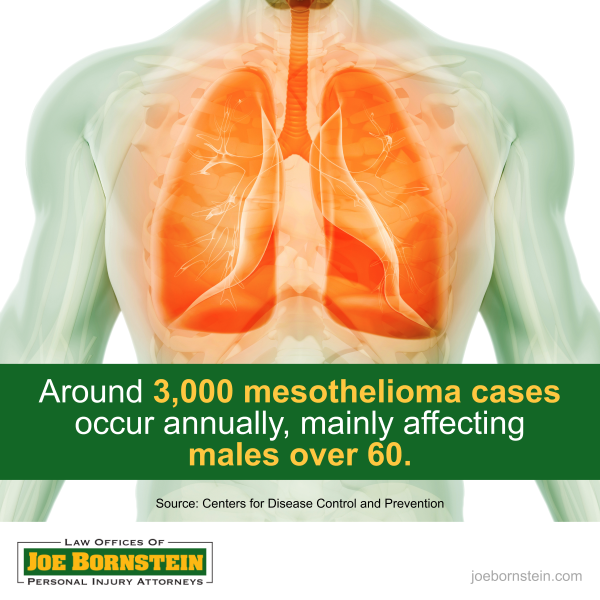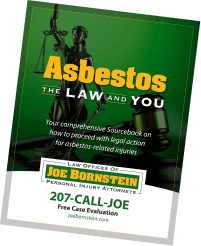Asbestos Exposure & Mesothelioma Lawyers in Maine
Experienced attorneys for victims of asbestos-related lung cancer
For decades, millions of people in Maine and across the United States were exposed to asbestos. It was widely used for insulation, strength, and fireproofing in a variety of applications. Asbestos is also a known carcinogen (cancer-causing substance) that affects the lungs, leading to significant health risks for those who were exposed, usually on the job.
If you have been diagnosed with an ailment from asbestos exposure, such as mesothelioma, you deserve experienced legal help. Turn to the Law Offices of Joe Bornstein for a free and confidential case evaluation. Don't delay. Call 1-207-360-8971.
Common past uses of asbestos
In the United States, asbestos was widely used in a variety of applications until it was partially banned in 1989.
Asbestos is nonflammable, noncombustible, and has an extremely high melting point, so many of its applications took advantage of these fire-resistant properties. Industries that depended on fireproofing, such as oil and gas, chemical refineries, and power plants, used asbestos extensively. Asbestos was also used in fire-resistant clothing worn by firefighters and industrial workers.
Another very common application of asbestos was insulation in both residential and industrial construction. It was used in attic and wall insulation, roofing and siding shingles, hot water and steam pipes, textured paint and patching compounds, and other construction materials. Pipefitting and pipe-wrapping materials also contained asbestos due to the material’s light weight, tensile strength, and non-corrosive properties.
Asbestos insulation was widely used in shipyards because fire prevention is critical at sea. It was incorporated into adhesives, bedding, cables, cement, hydraulics, gaskets, pumps, and textiles. The automotive industry also made extensive use of asbestos in brake systems and gaskets.
How asbestos exposure occurs
Asbestos is a mineral composed of long, thin fibrous crystals, each of which is made up of many microscopic “fibrils.” When asbestos is disturbed, these fibers can be released into the air and inhaled. The fibers then become stuck in the sensitive tissue around the lungs and abdomen, causing irritation, inflammation, and damage.
Most asbestos exposures occurred on the job. Professions that were most at risk include:
- All construction trades, including carpenters, masons, drywall installers, HVAC technicians, insulators, and tile setters.
- Demolition crews.
- Shipyard workers.
- Firefighters.
- Industrial workers, including mechanics, chemical workers, machinery operators, and maintenance workers.
- Power plant workers.
- Miners – particularly asbestos miners, for obvious reasons, but asbestos was also used in mining equipment.
- Automotive workers.
- Railroad workers.
Many people were exposed to asbestos while serving in the military. Navy veterans are particularly at risk because of the wide use of asbestos in shipbuilding, but all branches of the armed services used asbestos in buildings and vehicles.
Family members of workers in these industries are also at risk. A worker exposed to asbestos may have brought the fibers home on their clothes or hair, putting family members at risk of mesothelioma from second-hand exposure.

Top Maine job sites where asbestos exposure occurred
Until the late 1980s, numerous Maine workers were exposed to asbestos at a wide variety of job sites, especially in the shipbuilding and paper industries as well as power plants, transportation facilities, military bases, and even school and college buildings with asbestos building materials. Some of the top job sites for asbestos exposure in Maine included:
Shipbuilding
- Bath Iron Works (Bath)
- New England Shipbuilding Corporation (South Portland)
- Portsmouth Naval Shipyard (Kittery)
Paper Mills
- Great Northern Paper Company (Millinocket)
- Hudson Pulp and Paper Company (Augusta)
- Rumford Paper Mill (Rumford)
- International Paper Company (Livermore Falls)
- Oxford Paper Company (Rumford)
- S.D. Warren Paper Mill (Westbrook)
- Kennebec River Pulp & Paper Company (Madison)
- Eastern Fine Paper and Pulp (Brewer)
- Pejepscot Paper Company (Topsham)
- Maine Seaboard Paper Company (Bucksport)
- Georgia Pacific Paper Mill (Woodland)
Other Manufacturing
- Sanford Textile Mill (Sanford)
- New England Insulation Company (Bangor)
- Union Chemicals Company (South Hope)
- Northern Chemical Industries (Searsport)
Power Plants
- Central Maine Power Company (Augusta)
- Bangor Hydro-Electric (Bangor)
- Yankee Nuclear Power Plant (Wiscasset)
- Wyman Power Station (Yarmouth)
- Brunswick Electric Light and Power Company (Brunswick)
Transportation
- Maine Central Railroad Company (Waterville)
Military
- Dow Air Force Base (Bangor)
- Naval Air Station Brunswick (Brunswick)
- Loring Air Force Base (Limestone)
Schools & Colleges
- University of Maine (Orono)
- Pownal State School (New Gloucester)
- Colby College (Waterville)
- Mount Blue High School (Jay)
Remember, although most exposure occurred on the job, asbestos claims involve taking legal action against the manufacturer of asbestos projects, not your former employer.
How asbestos causes mesothelioma and lung cancer
When asbestos fibers enter the lungs, they cause chronic inflammation and irritation. Over many years, this inflammation can lead to cellular damage and uncontrolled growth. Asbestos fibers can also obstruct cellular processes and cause cells to copy incorrectly. Moreover, asbestos fibers can produce molecules called free radicals that damage DNA. All of these factors dramatically increase the risk of lung cancer.
While the risk of cancer increases with the amount of exposure, there is no “safe” level of asbestos exposure. Even brief periods of exposure to asbestos dust – for instance, a summer job at a shipyard – can lead to mesothelioma decades later.
Mesothelioma and other diseases caused by asbestos
Exposure to asbestos is the only known cause of mesothelioma, a malignant cancer that affects the tissues that line the lungs, stomach, heart, and other internal organs. The most common type of mesothelioma is called pleural mesothelioma, which affects the lining of the lungs. Early symptoms of pleural mesothelioma can include:
- Shortness of breath
- Dry cough
- Chest pains
- Weight loss
- Fatigue
Other, rare forms of mesothelioma include peritoneal mesothelioma (which affects the lining of the stomach) and pericardial mesothelioma (which affects the lining of the heart).
Asbestos can also cause other forms of lung cancer, including small cell lung cancer (SCLC) and non-small cell lung cancer (NSCLC). While lung cancer is commonly associated with smoking, research has found a synergistic effect between smoking and asbestos – that is, smokers who were also exposed to asbestos have a much higher risk of lung cancer than smokers who were not exposed.
Asbestos can also cause non-cancer diseases including asbestosis, a chronic lung condition that causes shortness of breath, wheezing, a persistent cough, and chest pain.
Legal options for Mainers with mesothelioma and other asbestos diseases
While asbestos was banned in most applications decades ago, the effects of asbestos exposure, including mesothelioma, continue to crop up because of the long period symptoms take to develop from the time of exposure. According to the Centers for Disease Control and Prevention, about 3,000 cases of mesothelioma are diagnosed every year, mostly in men over the age of 60.
Depending on the circumstances, mesothelioma victims have two main avenues to pursue compensation.
If the company that manufactured or distributed asbestos products is still in business, you may be able to pursue a mesothelioma lawsuit. This is a civil claim for damages including medical expenses, lost income, pain and suffering, and other costs associated with mesothelioma. Families who lost a loved one to mesothelioma may likewise be able to pursue a wrongful death claim against the asbestos manufacturer.
Starting in the 1990s, many asbestos manufacturers filed for bankruptcy and established asbestos trust funds (ATF) to compensate future victims as they come forward. As such, you may be eligible to file a trust fund claim. Industry figures indicate that over $30 billion has been set aside for victims in over 65 trust funds. There are specific eligibility criteria that must be met to file a trust fund claim and obtain compensation for mesothelioma or another asbestos-linked disease.
You may be eligible to file one or more lawsuits and/or one or more trust fund claims, depending on when, where, and how you were exposed to asbestos. There is no single average settlement or payout for mesothelioma, but it’s not unusual for victims to recover $1 million or more.
While most asbestos exposure occurred on the job, victims typically take legal action against the manufacturers, not their former employers.
If you or a loved one is a victim of asbestos exposure, call Joe today.
Pursuing compensation for mesothelioma or another asbestos-linked disease is a complex process. Because the exposure may have occurred many years ago, it’s often necessary to dig into decades-old purchase order histories and other documents to confirm when and where the victim was exposed to asbestos. It’s also not always clear which state’s laws apply, especially if you were exposed to asbestos at jobs in multiple states.
We can help sort out these complexities, get to the bottom of what happened, and explain all of your legal rights and options. Our team of attorneys can guide you through the process of filing a trust fund claim and/or a civil lawsuit, taking care of the paperwork and legal complexities while keeping you informed about the progress of your case.
You don't have to pay us anything before you win your mesothelioma settlement or asbestos trust fund payout, and there is no cost for a free case evaluation. If you or a loved one has been diagnosed with mesothelioma or another disease linked to asbestos, get the help you need and the justice you deserve by calling the Law Offices of Joe Bornstein. Contact our offices today at 1-207-360-8971.




